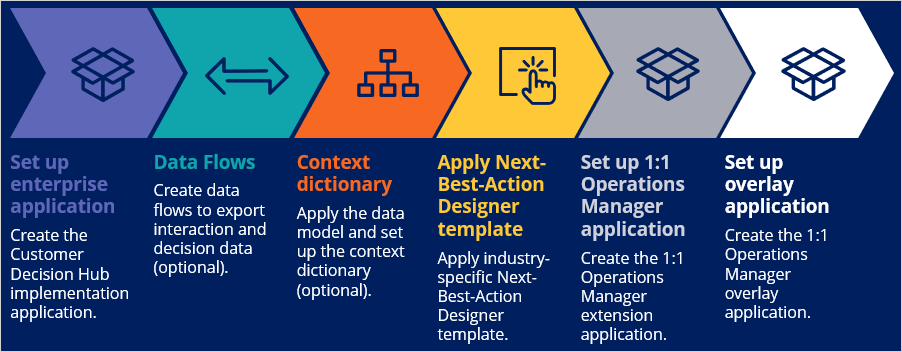
Pega Customer Decision Hub setup wizard
The Pega Customer Decision Hub™ setup wizard provides an automated, end-to-end process to complete the essential setup tasks of the Customer Decision Hub application. You can use the wizard to efficiently enable your team to immediately start development.
During the setup, you can pick from various industry templates that contain preconfigured best practices for data model and Next-Best-Action Designer configurations. Optionally, you can choose the Other option and upload Pega-provided components from the Pega Marketplace or your own data model and Next-Best-Action Designer templates. It is also possible to skip these configuration steps. In this case, you manually define the data model, and then configure the context dictionary. To save time and effort, it is recommended to define the data model and Next-Best-Action Designer configuration through the wizard.
You run this application setup only once in the development environment. To allow change management and support different release cycles between technical (structural changes) and marketing operations (content changes) in the project lifecycle, Pega 1:1 Operations Manager application is configured from day one. When the project is at the stage of maturity to engage change management, all environments are synced, and the business content team can start introducing new content in the business operations environment (BOE) by using 1:1 Operations Manager.
You can select a repository where the system automatically exports customer interactions and (optionally) decisions to support reporting and audit requirements, without creating custom flows. If your application is deployed in a Pega Cloud services environment, Pega Cloud File Storage is preconfigured for you as a default repository. The name of this repository in your application is pegacloudfilestorage. You can select this repository or a different one as your decision repository. For on-premises and client-cloud implementations, the system administrator typically configures the repository before running the wizard. Alternatively, system administrators can configure the repository after setting up the application.
A public repository that is hosted by Pega contains all artifacts that are required to apply the data model and Next-Best-Action Designer templates. This repository is automatically updated when new industry frameworks become available.
An operator with the CDHTemplate:CDHInstall access group initiates the setup process; when the operator logs in, they launch the new setup wizard in the development environment. To ensure security, the system administrator manually creates this operator during a new environment provisioning.
The setup wizard requires three details from the user: the industry, the decisioning repository, and the organization name. Depending on the system deployment (Pega Cloud, client cloud, on-premises), you might not need to enter some of this information.
For Pega Cloud customers, the decision repository is predefined and selected for you. You can still select a different repository if one exists. As a result, only organization name is required in the setup wizard. If the organization name is already defined in your environment, then this step will be skipped as well. Third-party cloud and on-premises customers can provide the organization name during the setup process; the system administrator preconfigures a repository, which you can also define after the initial configuration is complete.
When you initiate the setup, the process is queued so that no other action impacts the user experience. The wizard provides an audit trail, and you can download the logs when the process ends.
The setup process first creates the Customer Decision Hub implementation application. In this application, the project team completes the initial configuration. This application is built on the Pega Customer Decision Hub framework. When the implementation application setup is complete, the wizard generates the data flows for exporting interaction and decision files to the repository that you provide during the setup process.
The context dictionary defines the entities to whom Customer Decision Hub communicates next-best-action decisions (primary context) and builds the associations between these entities. If you select an industry, the setup wizard generates the data model and builds the associations between the entities according to the best practices for that industry. The wizard applies the best practices to name the entity classes by using the organization name that you provide during the setup steps. This process also generates additional artifacts such as Next-Best-Action Designer strategies, adaptive models, properties, data flows, and data sets that are required to implement Customer Decision Hub. If you do not select a data model, you manually build the entities and their associations in the context dictionary after running the wizard.
When the wizard generates the context dictionary, it automatically applies the Next-Best-Action Designer template (if it was selected). This action creates the taxonomy, a set of contact policies, engagement policies, and real-time containers that help to start the implementation process. If you do not provide a template during the process, then you can manually set up Next-Best-Action Designer from an empty configuration.
Lastly, the setup wizard generates two additional applications. 1:1 Operations Manager is the overlay application where the business content team continuously builds new actions and treatments. This application is built on Customer Decision Hub and the 1:1 Operations Manager extension with predefined configuration to set the stage for change management. You can use the application after the environment is mature enough and migrated to the business operations environment. The 1:1 Operations Manager extension application is where system architects can customize the process and user experience of 1:1 Operations Manager. This application is built on Pega 1:1 Operations Manager. Both Customer Decision Hub and 1:1 Operations Manager extension applications should be built on Pega DevOps to use the Deployment Manager capabilities during migration.
Challenge
Tip: To practice what you have learned in this topic, consider taking the Running Pega Customer Decision Hub setup wizard challenge.
This Topic is available in the following Module:
If you are having problems with your training, please review the Pega Academy Support FAQs.
Want to help us improve this content?


